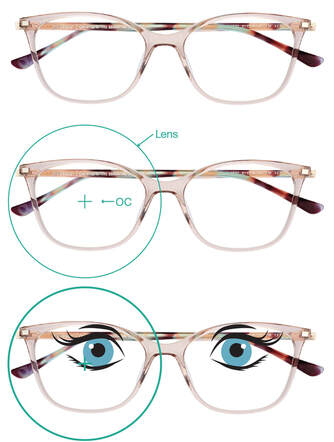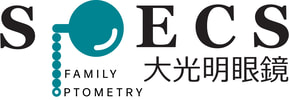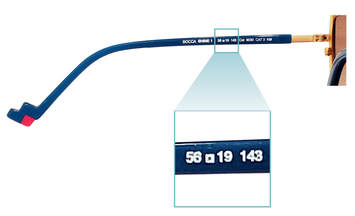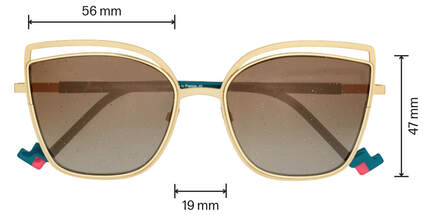Frame Shopping 101
Shopping for the perfect frames and lenses can be very confusing, we totally get it! Just like shopping for a tailored suit, measurements are super important because everyone's face shapes are different. Additionally, at the end of the day, glasses are a medical device and in order to have the perfect end product, we need to obtain good, precise measurements.
We're here to break it down and make it as easy as possible! Our patients are amazed how simple and painless it is and how great they look in the end! Here are the basics to take into account when shopping for the perfect pair of glasses.
We're here to break it down and make it as easy as possible! Our patients are amazed how simple and painless it is and how great they look in the end! Here are the basics to take into account when shopping for the perfect pair of glasses.
#1 - Frame Measurements
Sizes for frames don't come in small, medium, large measurements. If you look at your temples (the legs of your glasses), there will likely be numbers on the inside, typically it will be on the inside of the left temple. For example, for the one in the example below, it reads "56 ⃞ 19 143".
A MEASUREMENT
The 56 is what we refer to as the "A measurement" (aka. eye size) which tells us how wide one of the lenses are, from the furthest point temporally (outside closest to your temples) to furthest point nasally (closest to the nose).
DBL or BRIDGE
The 19 tells us the DBL (distance between lenses) or the bridge width -- from nasal edge of one lens to the nasal edge of the other lens.
TEMPLE
Lastly, the 143 tells us the length of the temples. 140-150 is generally pretty standard for the adult temple.
B MEASUREMENT
Another valuable measurement to know is the B measurement, which is the depth of the lens. This is especially important for high myopes (those with a '-' prescriptions) or hyperopes (those with a '+' prescriptions) -- you do not want a high B- (or A)-measurement because it will make the lens larger and heavier. B measurements are not normally listed, but if you inquire, they can easily be measured if needed.
*NOTE: All these measurements are in millimeters (mm).
The 56 is what we refer to as the "A measurement" (aka. eye size) which tells us how wide one of the lenses are, from the furthest point temporally (outside closest to your temples) to furthest point nasally (closest to the nose).
DBL or BRIDGE
The 19 tells us the DBL (distance between lenses) or the bridge width -- from nasal edge of one lens to the nasal edge of the other lens.
TEMPLE
Lastly, the 143 tells us the length of the temples. 140-150 is generally pretty standard for the adult temple.
B MEASUREMENT
Another valuable measurement to know is the B measurement, which is the depth of the lens. This is especially important for high myopes (those with a '-' prescriptions) or hyperopes (those with a '+' prescriptions) -- you do not want a high B- (or A)-measurement because it will make the lens larger and heavier. B measurements are not normally listed, but if you inquire, they can easily be measured if needed.
*NOTE: All these measurements are in millimeters (mm).
#2 - PD and Ocular Center

Without getting too much into the physics of things (if you want to learn about the physics of things more, check out my blog post on this), each lens has an "ocular center" (OC), usually found near the center of the lens. To have the best visual experience, minimizing any distortion, your should be looking out of this point on the lens -- meaning your pupils (the dark spot in the center of your eye you see out of) should line up with the lens' OC.
In the diagram here, you can see that the pupils do not line up with the lens' OC. If you are the wearer of this frame, you may experience distorted vision, headaches, or dizziness, depending on what your prescription is and how well you may (or may not) adapt to it being this far off.
To make the best possible pair of glasses, we always take 2 measurements: your PD (pupil distance) and your ocular center/height (the height of your pupils in relation to the frame). This helps us ensure that when we cut the lens down to shape and size, the OC of the lens will sit where your pupils sit on the frame. The higher your prescription (and if you are considering progressive/bi-focal lenses), the more we want to ensure these measurements are accurate.
In the diagram here, you can see that the pupils do not line up with the lens' OC. If you are the wearer of this frame, you may experience distorted vision, headaches, or dizziness, depending on what your prescription is and how well you may (or may not) adapt to it being this far off.
To make the best possible pair of glasses, we always take 2 measurements: your PD (pupil distance) and your ocular center/height (the height of your pupils in relation to the frame). This helps us ensure that when we cut the lens down to shape and size, the OC of the lens will sit where your pupils sit on the frame. The higher your prescription (and if you are considering progressive/bi-focal lenses), the more we want to ensure these measurements are accurate.
#3 - Lens Materials & Coatings

Typically, lenses are going to be made of polycarbonate, a strong, bulletproof plastic. Other possible materials we may consider are CR-39, trivex, or high index plastics in 1.67 or 1.74 indexes.
The higher your prescription the thicker the lens will be. Similarly, the higher the index [of refraction] the thinner the lens. We typically recommend that those with prescriptions higher than -4.50 consider going into a high index 1.67 lens, and those with a -8.00 or higher should consider the thinnest possible, if they are concerned with the weight/thickness of the lens. Children are the only exception to this guideline. In California all children must be fit in polycarbonate lenses for safety reasons.
There are various coating options you may also choose to add onto your lenses. Regardless of your needs for your glasses, a standard anti-reflective coating is generally a must for the best visual experience from your lenses. During your consultation, either live or virtual, we will discuss your needs and recommend options such as Transitions, upgraded anti-reflective coatings, or polarized lenses for sunglasses.
The higher your prescription the thicker the lens will be. Similarly, the higher the index [of refraction] the thinner the lens. We typically recommend that those with prescriptions higher than -4.50 consider going into a high index 1.67 lens, and those with a -8.00 or higher should consider the thinnest possible, if they are concerned with the weight/thickness of the lens. Children are the only exception to this guideline. In California all children must be fit in polycarbonate lenses for safety reasons.
There are various coating options you may also choose to add onto your lenses. Regardless of your needs for your glasses, a standard anti-reflective coating is generally a must for the best visual experience from your lenses. During your consultation, either live or virtual, we will discuss your needs and recommend options such as Transitions, upgraded anti-reflective coatings, or polarized lenses for sunglasses.
And those are the basics of what to look out for when shopping for eyewear!
During your consultation, we will go over your lifestyle habits, concerns, and recommend the best products for you. Each person has different visual needs. The engineer who spends 8-10 hours in front of their computers uses their eyes much differently than doctors or nurses who may look over charts before diagnosing and treating patients.
Our goal is to get you in the best pair of glasses! Ones that fit your personality and style, while enhancing and protecting your vision so you may see all things clearly and comfortably! Chat with us about scheduling an in person or virtual consultation!
During your consultation, we will go over your lifestyle habits, concerns, and recommend the best products for you. Each person has different visual needs. The engineer who spends 8-10 hours in front of their computers uses their eyes much differently than doctors or nurses who may look over charts before diagnosing and treating patients.
Our goal is to get you in the best pair of glasses! Ones that fit your personality and style, while enhancing and protecting your vision so you may see all things clearly and comfortably! Chat with us about scheduling an in person or virtual consultation!


